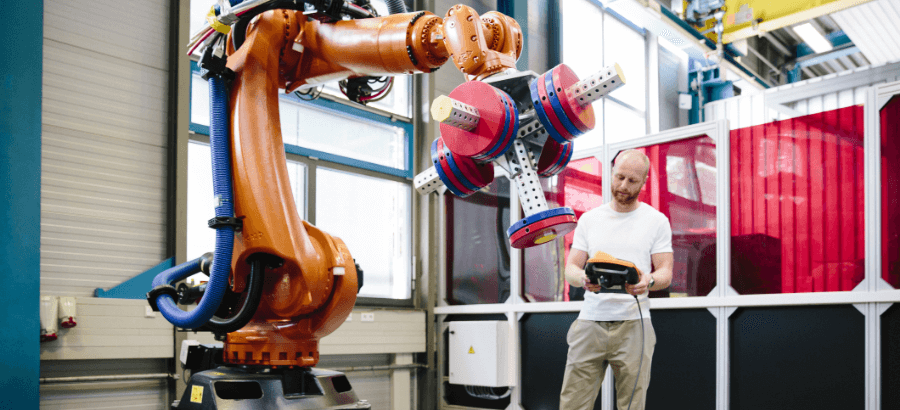“So far, our application of universal transfer devices has been rather smooth. It does present a training requirement, the need for new skills for industry 4.0 because there will be a great force of technical specialists to operate and maintain the machines. We’ve moved slowly in this area.”
— Paul F. Guy, Ford Motor Company’s director of manufacturing, engineering, and systems, discussing the application of robotics into its business.
A meeting between two pioneers during a cocktail party in 1956 turned out to be a defining moment in the world of manufacturing. It was during this party that American inventor George Devol, the designer of the first mechanical arm, met with Joseph Engelberger, the father of robotics. Together they conceived the Unimate, the very first industrial robot. By the late fifties, the Unimate #001 prototype was installed on an assembly line for the first time at a diecasting plant in Trenton, New Jersey.
When designing the prototype, Devol and Engelberger abided by Asimov’s Three Laws of Robotics, underpinned by the principle that a robot may not allow a human being to come to harm. The aim of this technological advance was to simply augment and enhance human ability.
Of course, robotics does not tell the full story, as the world of manufacturing has evolved even further over the last few decades, with the rise of data and smart, autonomous systems. The term ‘Industry 4.0’ was coined in 2011 to describe this new era of new technological innovations including advances in AI, ML and cloud computing as well as data analytics.
While all of these technologies have been aimed at improving operational efficiencies, one concerning factor remains. The growing skills gap.
While the industry has been transformed by new technological advances, the workforce has had to play catch-up. Technological advances has often moved faster than digital capabilities. In most cases, skills development has not been a top priority throughout these exciting transitions.
This challenge remains prominent today. The recent SYSPRO research survey entitled ‘Realigning the links of the disconnected supply chain’ shows that while 38 percent of businesses upskilled staff to use business systems to their full extent to drive effective and efficient business operations in the face of disruption, 61 percent of businesses had no intention of building long terms skills training programs to enable a digital workforce.
As a result, employees are unable to adapt and thrive in Industry 4.0. The onus Is now on manufacturing leaders to help employees through these transitions. Success will be dependent on three factors:
1. Skills development as a central component of your digital roadmap
2. Ongoing training initiatives
3. Technology to further augment employee development
1. Skills development as a central component of your digital roadmap
Part of the challenge in empowering employees to adapt to Industry 4.0 may be due to a lack of a formal and deliberate focus in skills development. It goes without saying, that in order for the skills deficit to be reduced significantly, skills development needs to be central to a business digital strategy.
When building the strategy, business leaders should assess what type of skills are needed currently, for the future and whether the current employee base that is being recruited is ready for these changes. According to Indeed.com, that broad skills set should include digital fluency, big data analytics and even knowledge around technologies such as ERP. Roles will also evolve, with the introduction of Predictive Supply Network Analysts, the Smart Quality Assurance (Q.A.) Manager and even the Smart Factory Manager. Businesses will need to prepare for this inevitability.
2. Rollout ongoing training opportunities
Change management and ongoing training opportunities should also be included as part of a digital transformation strategy to ensure that any technological investments are embraced, adopted and sustained.
Take for example the implementation for an ERP system. For some employees, it may be the first time they have used a new version of an ERP system. A change management process will ensure that a company’s digitally-enabled ERP system will be utilized more effectively, ensuring that a business gains the most of that investment. Skills development is also one of the most important aspects to safeguarding your ERP because employees need to be in touch with technological evolution and new developments. Employers should take advantage of the digital courses offered by ERP providers to prevent any erosion of technological knowledge.
3. Technology meets human capability in the middle
While technologies have widened the skills gap, technologies can also be used to close it. A good example is the rise of Low Code tools, which are now enabling the rise of the citizen developer due to their ability to plug into ERP systems as a single point of organizational data. Technology also enables more efficient training. According to the World Economic Forum, successful education isn’t as simple as giving someone the manual and a desired outcome. There are multiple factors that unite successful training programs, from clear educational priorities to sound curriculum design. This is where technology comes in – to monitor the success of a training programme and identify areas of improvement.
While the robotic arm has been around for decades, the success behind the factory of the future will still rely heavily on a human-first digital culture. A 2021 study conducted by Deloitte and the Manufacturing Institute (MI) predicts that 2.1 million manufacturing positions will go unfulfilled by 2030. These empty positions could cost the U.S. a loss of about $1 trillion in GDP. It’s therefore never been more vital to enable your workforce by ensuring that skills development and training is a central component in your overall digital strategy.








1 thought on “Industry 4.0: Building the right skills to meet the factory of the future”